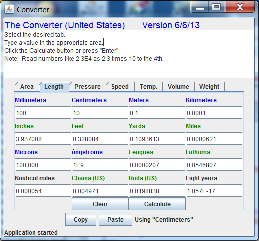
Converter

This page was designed before it became impossible to use applets on web pages.
So, unfortunately, you will probably be unable to run the program on the web page.
Instead you will need to download the zip file. You can run the applet using this
command at a DOS prompt in the subfolder:
appletviewer Converter.html
Alternatively, you can run it as an application using its jar file by typing the
following at a DOS prompt:
java Converter -jar
In Windows, you may be able to run the ap by just double clicking on the
Converter.bat file in the folder holding the files.
James Brink, July 27, 2018
The Converter can convert many types of units to different units. For example, it can convert kilometers into miles and feet, gallons into liters and cubic feet, grams into ounces and kilograms, and so on. Enter one measurement and it will display the value in 5 to 15 other units. They include metric, standard American units, and some additional measurements. Types of measurements include
There are over 1,100 conversions in all.
There is just one Java program but it can be used in a variety of ways. Some of those ways allow copying value to and from the Converter. Because there are certain security risks poised by some Java applets and applications, you may be warned about those risks in a manner that makes it seem more dangerous than it really is. When you load some configurations of the program, you will be presented a dialog saying that the Publisher is "UNKNOWN" and "Running this application may be a security risk." You will have to check the box "I accept the risk and want to run this application" and click "Run" in order to use the Converter.
James Brink, retired professor
Department of Computer Science and Computer Engineering
Pacific Lutheran University,
Tacoma, Washington
brinkje@plu.edu
It possible to download the application's zip file, expand it and run the Converter directly on your computer.
Suppose we want to know how many inches of rain (ignoring evaporation) are needed to fill rain barrels totaling 500 gallons if the barrels are filled with runoff from a roof that measures 13.5 ft. by 39 ft horizontally. Using the Converter, we use the volume tab. Type 500 under "Gallons" and find that it corresponds to 66.84028 cubic feet. We can copy it into JavaCalc5 or type this value into your favorite calculator. We divide by 13.5 and 39 to find the number of feet of rain needed. To get inches, we multiply by 12 to get inches. The result is 1.52 inches of rain will provide 500 gallons of rain water.